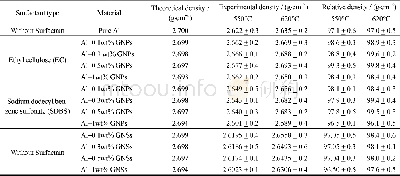《Table.1.Response of experimental and relative densities of the two surfactant (EC and SDBS) assiste
 提示:宽带有限、当前游客访问压缩模式
提示:宽带有限、当前游客访问压缩模式
本系列图表出处文件名:随高清版一同展现
《Surfactant-decorated graphite nanoplatelets(GNPs) reinforced aluminum nanocomposites: sintering effects on hardness and wear》
The reported possible strengthening mechanisms for graphene-reinforced nanocomposites were due to the synergistic effect of grain refinement,load transfer,thermal expansion mismatch,and Orowan looping[26].Among these,load transfer,and grain refinement effects are more prominently displayed by graphene due to its unique 2D geometry,higher surface area,and formation of the strong interface at both sides of the sheet faces.An increase in hardness of the nanocomposite is the direct indication of grain refinement as they have a very close relationship.The addition of GNPs produces a pinning effect at the boundaries and acts as a grain growth inhibitor leading to an increase in hardness.As such,the grain sizes of GNPs-reinforced Al nanocomposites at both sintering temperatures were measured to investigate the possible grain refinement effect as shown in Fig.7.Both trends at two sintering temperatures validate the fact that graphene has developed a significant pinning effect and the grain size has reduced as compared to pure Al;this is characteristic of graphene for grain refinement[27-28].However,surfactant-assisted GNPs-reinforced Al nanocomposites produce more pinning effect than a pure GNPs-reinforced Al matrix.Another aspect of increased hardness is the effective load transfer from the ductile matrix(Al)to the uniformly dispersed surfactant-decorated GNPs.This can occur as a strong interface that may develop with the Al as there is a high surface area containing GNPs coated on the Al surfaces[7].
| 图表编号 | XD002873300 严禁用于非法目的 |
|---|---|
| 绘制时间 | 2018.06.01 |
| 作者 | Zeeshan Baig、Othman Mamat、Mazli Mustapha、Asad Mumtaz、Sadaqat Ali、Mansoor Sarfraz |
| 绘制单位 | Department of Mechanical Engineering, Universiti Teknologi PETRONAS、Department of Mechanical Engineering, Universiti Teknologi PETRONAS、Department of Mechanical Engineering, Universiti Teknologi PETRONAS、Department of Fundamental and Applied Sciences, Uni |
| 更多格式 | 高清、无水印(增值服务) |
查看“Table.1.Response of experimental and relative densities of the two surfactant (EC and SDBS) assisted GNPs/Al and GNPs/Al”的人还看了
-

- Table 2 Variance analysis of the effects of different planting densities and row spacing on plant productivity (inter-su





